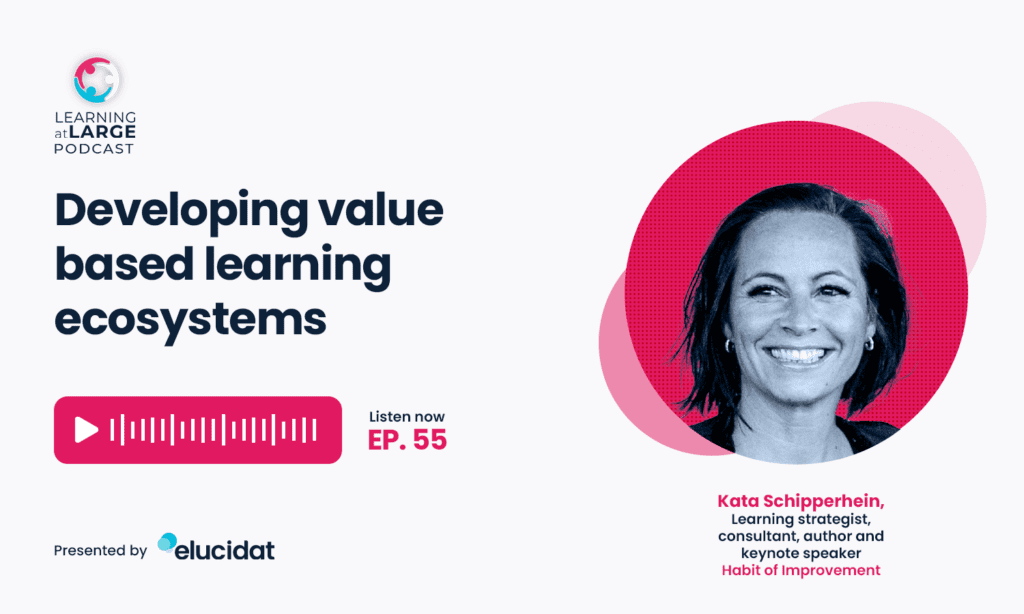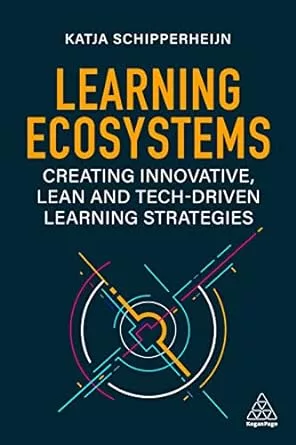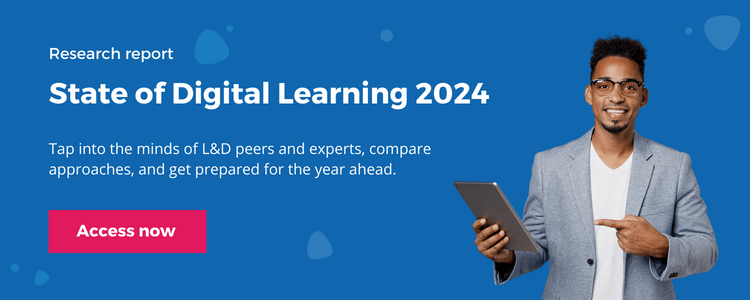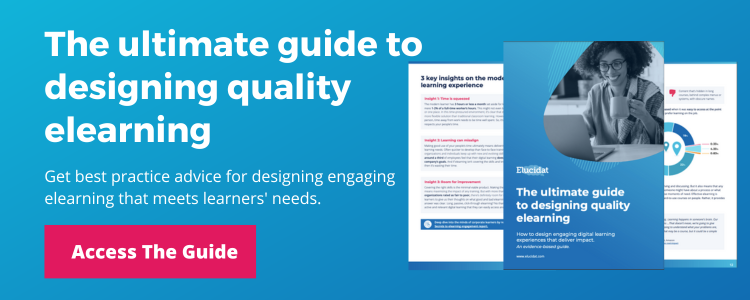Developing Value-Based Learning Ecosystems: Katja Schipperheijn
Despite the rapid digital transformation of recent years, learning and development approaches have barely shifted. Hear why Katja Schipperheijn, learning strategist, consultant, author and keynote speaker, thinks we need a new future-focused L&D model. Discover how innovative tech-driven strategies are critical for empowering continuous people-centered learning. Find out why values need to be at the heart of a connected learning ecosystem.

Top tips for developing effective learning ecosystems
Don’t have time to listen now? Here are some top tips from Katja:
- Get future focused with a new L&D approach: Catch up with the speed and scale of the digital transformation by embracing a new model of L&D.
- Break down the silos: You can’t create a new learning landscape alone. Get your stakeholders aligned. Work in collaboration with other departments.
- Connect knowledge with technology: Bring knowledge sharing and technology together in your learning ecosystem. Don’t tackle this in one go. Break it down. Take small steps.
- Put humans at the heart: Understand your organization’s values. These need to be at the center of your learning ecosystem for it to be effective.
1. Get future focused with a new L&D approach
The pandemic caused huge disruption to the way we work. Organizations rapidly adopted new technologies and pivoted approaches to keep going during lockdowns and beyond. Despite the speed and scale of the digital learning transformation, L&D thinking and frameworks remained largely unchanged.
It’s clear to Katja that new learning technology has simply been slotted into an old model. But is this approach sustainable? With Artificial Intelligence (AI) and other technological advances becoming key to achieving business goals, can L&D afford to remain unchanged?
“A couple of months into the pandemic, I saw that actually nothing was changing in the way that we use technology. Even though it can help us, what I saw was more and more frustration. I looked back at my learning maturity model and I saw that all these companies were still using technology as they were 10 years ago…But with AI and all these technologies becoming easier to implement, if you don’t do it right now, you can’t wait another year, because then you’ll be out of business.’’
2. Break down silos
L&D needs to lead a new tech-driven approach to empower continuous people-centred learning. And that’s no mean feat. It involves changing how learning and development is perceived in your organization. L&D doesn’t just deliver learning content. It’s responsible for creating the organization’s learning landscape. In the right landscape, employees learn, grow and develop themselves.
Of course, you can’t do this alone. Katja highlights that it’s critical you get your stakeholders engaged and aligned. That means breaking down your organization’s silos and working in together with other departments.
“The urgency is in L&D themselves taking the lead. Don’t wait until you get a question from the business. Become the strategic advisor…Go to your departments, like marketing. They have a lot of knowledge of how to influence people to change their behavior…Go to the people from IT. Work together. I think breaking down the silos and working together as a strategic office for the future, that’s what we need right now.”
3. Connect knowledge with technology
Organizations are packed with knowledge. However, it often isn’t effectively shared. When employee expertise is captured, it’s locked away within systems and databases, like SharePoint. This stops an organization’s learning culture from flourishing.
For Katja, human sharing and technology need to come together in a learning ecosystem that enables efficient social collaboration. Whether it’s using OpenAI or other technology, it’s about connecting the dots. Your ecosystem needs to enable everybody to access the required knowledge at the point of need.
Developing this kind of learning ecosystem can feel overwhelming – particularly if you have numerous legacy systems in play. Don’t try to change your whole ecosystem immediately. Break it down and take small steps.
“As a first step, we need to work together in social collaboration. We sometimes have tools that help us, for example, an intranet page. But still, technology isn’t helping us. In [effective] learning ecosystems, the technology will match the knowledge and information that you need at a certain moment in time. It will give you everything in like three seconds, for example, that’s what OpenAI is doing. So, if we combine the human sharing of knowledge with technology, it’s much more efficient.”
4. Put humans at the heart
From work culture to corporate social responsibility, what an organization stands for is increasingly important to its current and future workforce. So, although technology is a key element of your learning ecosystem, it shouldn’t be at its center.
Katja explains that a learning ecosystem needs to be built around an organization’s value system if it’s going to be effective. This isn’t a one-off decision. It’s an ongoing conversation. Whether you’re introducing new ways of working or exploring the latest technology, it needs to align with your values and future vision for your company.
“Our children don’t want to work for a company that doesn’t have the same purpose as they have. Corporate Social Responsibility can no longer be a buzz word or a marketing tool…You see technologies [being considered] when we think about attracting the future workforce. This is around their values…You need to understand the environment, the culture of the organization, before you can say these technologies are in line with the values and the vision of the company of the future.”
A quick recap
L&D has long lagged behind technological advancements. Katja has four strategies to change this and develop a future focused learning ecosystem.
- Catch up with the digital transformation by deploying new L&D thinking and frameworks.
- Drive the change to lead tech driven strategies in collaboration with your colleagues.
- Bring knowledge sharing and technology together in your learning ecosystem.
- Make sure your learning ecosystem has your organization’s values at its heart.
Want to find out more about developing a thriving learning ecosystem? Check out the full podcast.
About Katja
Katja has been researching all things L&D for over 20 years. She’s an internationally recognized learning strategist, consultant, author and keynote speaker on innovation and learning in a virtual world.
You can find out more and get connected with Katja on LinkedIn.
On Katja’s reading lists
As well as picking up Katja’s latest book, Learning Ecosystems, check out her L&D reading recommendations.

This book explores the psychology and neuroscience that underpins effective and successful training and learning.
Katja is excited about this upcoming release. It provides strategies, tools and insights to move from the traditional role of L&D teams to being a trusted business partner.
Looking for more reading tips? Check out our book blog.
Learn more from like-minded learning experts
Interested to hear more from Katja as well as other learning experts and your L&D peers? The State of Digital Learning Report is the place where you can tap into the minds of your L&D peers and learning experts, compare approaches, and get prepared for the year ahead.

